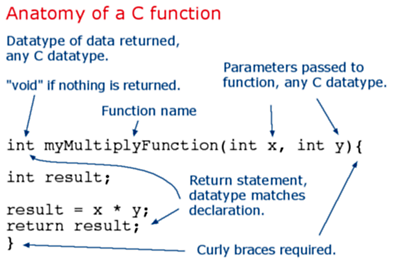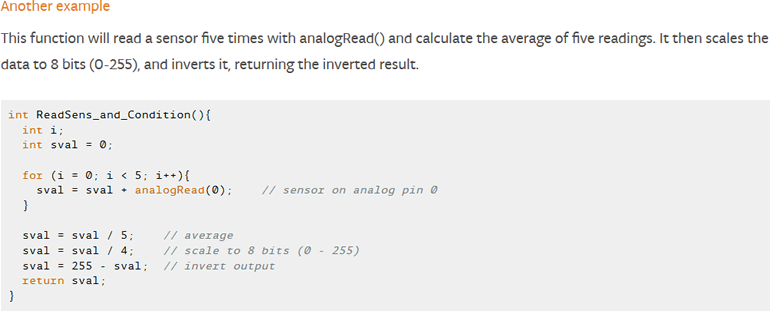 Many of the subtasks your code is required to perform is best developed in short, modular chunks, called functions (aka methods, subroutines). In this way, it is both easy to identify and repair errors as well as reuse the code in future projects.
Many of the subtasks your code is required to perform is best developed in short, modular chunks, called functions (aka methods, subroutines). In this way, it is both easy to identify and repair errors as well as reuse the code in future projects.| RSGC ACES' Introduction to Functions in Arduino C |
Web: Arduino: Functions
Reference: AVR Foundations. pp. 45-46.
 Many of the subtasks your code is required to perform is best developed in short, modular chunks, called functions (aka methods, subroutines). In this way, it is both easy to identify and repair errors as well as reuse the code in future projects.
Many of the subtasks your code is required to perform is best developed in short, modular chunks, called functions (aka methods, subroutines). In this way, it is both easy to identify and repair errors as well as reuse the code in future projects.
Your mathematical understanding of a function, that returns a single value within the range of the function is a good place to start. The notation to the right is understood to mean that a value `x`, chosen from the eligible domain, is the input to the function. The expression defined by `f` replaces `x` with this input value and the expression is evaluated and returned to you as an element of the range, `y`.
The familiar setup() and loop() function headers are preceded by the void keyword because they are intended to perform a task, not return a single value. If the purpose of a function is to perform a calculation on one or more input values, the function header would replace the void keyword with another valid data type and use the return statement to both exit the function and pass back the calculated result.
 Functions in Arduino C, and (almost) any other other language, work in a similar manner. A call to a function can appear almost anywhere you would include a constant or a variable.
Functions in Arduino C, and (almost) any other other language, work in a similar manner. A call to a function can appear almost anywhere you would include a constant or a variable.
Example 1. Let's say in order to graph the function `f(x)=3x^2-1` in your notebook, you decide first create a table of values over the limited integer domain, [2,2]. You could easily do this by hand, but you want to try your hand at writing code to do it for you. You could write this.
![]() FunctionExample.ino
FunctionExample.ino

Comments on Example 1
sprintf is optional, but preferred for formatted output usage.y in line 16 and then simply return it in the next statement (although it supports clarity) This evaluation and exit could have been done in one return statement.int8_t over uint8_t for both domain and range values. However...float type to allow for decimal places.Example 2. Consider this improved version of Example 1...![]() FunctionExampleFloat.ino
FunctionExampleFloat.ino

Comments on Example 2.
for loops are simply consolidated while loops (initialization, terminal, and step in one line) and are encouraged for the iteration of ordinal sequences of integer or character types.float or double types) the formal while syntax is preferred.MIN and MAX to float (it appended .0).float type due to the heavy demands it places on Flash memory. Consequently, I've shown you an alternative way to provide formatted support for float types using the dtostrf() function. Overkill perhaps, but this at least gives you control over the number of desired decimal places.float (7 decimal places of accuracy). Within the Arduino C world, the double type is the same as float.y. The expression is evaluated and returned in a single statement.Create an Arduino project called Modularity, and add functions to realize each of the following requirements. Be sure to consider the best return type and thoroughly exercise each function by displaying results to the Serial Monitor.
maximum, that accepts two uint8_t parameters and returns the larger of the two.maximum function that returns the larger of three uint8_t input parameters.displayBinary that displays ALL eight bits of the uint8_t parameter, including the leading zeroes.uint8_t countBits (char ch)
dec2BCD that accepts a decimal value from 0 to 99, inclusive and returns its BCD equivalent.boolean result. Develop the predicate method isEven that returns true if the uint16_t input parameter is even and false otherwise.
Undertake minor improvements to this function.
PoVWord-Related Exercises
Open the FunctionPrimer sketch attached to an earlier email to our conference and provide bodies for the stub functions within. TBC.void shiftOut (uint8_t dPin, uint8_t cPin, uint8_t lPin, uint8_t dir, uint8_t endian, uint16_t value)The function will be invoked by this call,
shiftOut(DATA, CLOCK, LATCH, LSBFIRST, LENDIAN, segments);
Day 2 String-Related Examples and Exercises